Contents
- Variety of grapes from which Kindzmarauli wine is made
- How to make wine from grapes at home in a step-by-step recipe?
- Homemade wine: simple recipes
- Recipe 1
- Recipe 2
- Wine from the grape leaves
- How to make wine from Isabella grape at home?
- What sorts of grapes make white wine: the recipe for cooking
- What kind of grapes make red wine: the recipe for cooking
- Dry wine at home from grape
- Wine from frozen grapes
- Video: how to make wine at home from Isabella grapes?
In our time, every owner knows how to cook homemade wine, in which grapes grow in abundance. Nevertheless, a number of countries and regions have retained a reputation for producing unique wines by their taste. For example, Georgia, Alazani Valley, France, Italy.
Variety of grapes from which Kindzmarauli wine is made
 glass and bottle of Georgian wine Kinzmarauli
glass and bottle of Georgian wine Kinzmarauli Thanks to the spring flood of one of the rivers flowing from the mountains, the soil is enriched with minerals, lime and substances from the peaks. They together have a beneficial effect on the taste of Saperavi grapes and on the future wine from it.
In other regions of Georgia, this grape variety is used for making dry wines.
How to make wine from grapes at home in a step-by-step recipe?
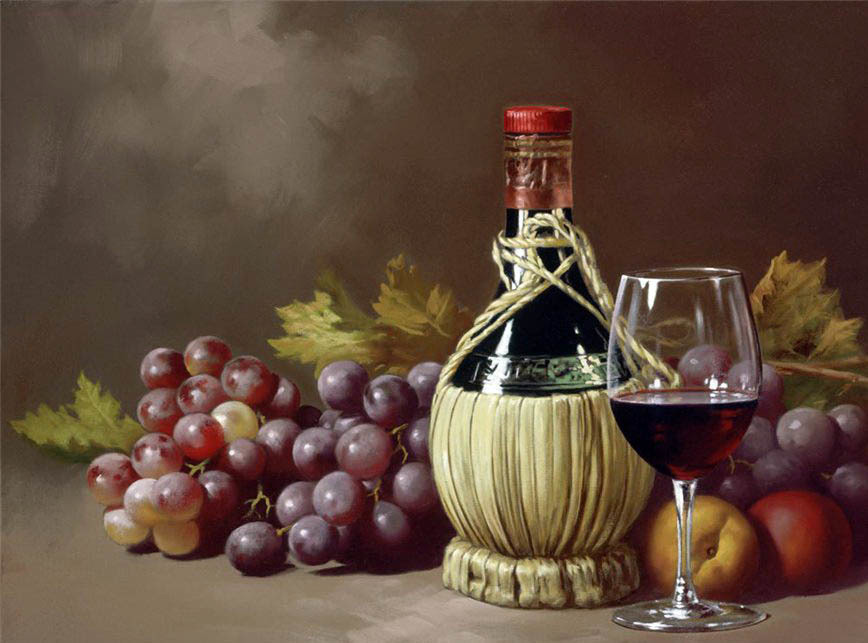 bunches of grapes, a bottle and a glass of house wine
bunches of grapes, a bottle and a glass of house wine Next we offer a step-by-step recipe for making home-made wine from ordinary blue grapes.
- Separate the berries from the cuttings and fold them into a tank of the pelvis type or bath, depending on the amount of grapes. Crush them with your hands or bare feet
- A special press for berries that will smash them into mush,
- will do. You do not need to wash grapes, because the necessary quantity of fermentation substances is present on its peel. If you have washed, stock up with special wine yeast, which you add to the grape juice at the fermentation stage
- . Collect the mash in a clean container with a wide neck so that it is filled no more than two thirds. The container must not be made of metal or aluminum.
- Place a container of copper in a room where the air temperature ranges from 18 to 23 ℃
- Cover the neck with a cloth to avoid attracting midges
- Mash the
- daily for five days. Separate grapes from juice, wort, for example, with the
- colander. Wort andPaste the cake for different capacities.
- In a bowl with sour add sugar at the rate of 50 g per liter
- After three days, try the taste of the future wine. If the sour is preserved, fill the sugar in the same proportion
- When the sweetness of the wort satisfies you and the acidity disappears, the fermentation is over and the wine is semisweet or sweet with an alcohol percentage of 15-17
- The wort sweetening stage and its ripening takes up to the month
- If youwant to get a little sparkling wine, then pour the finished sweet wort into bottles and lay it horizontally in a warm room for a few days. If you do not need gas bulbs, proceed to the next stage of
- Pour the can into the jars so that they are filled to three-quarters of the
- Lower the cans into the hot water 75 ℃
- Remove the jars and put them on the stoppers with a tube, one end of which is lowered into a jar of wine and the other into a glass of water. Watch the release of carbon dioxide
- When the wine is calm, pour the home low-alcohol beverage into bottles and take them to the cellar or cellar
Homemade wine: simple recipes
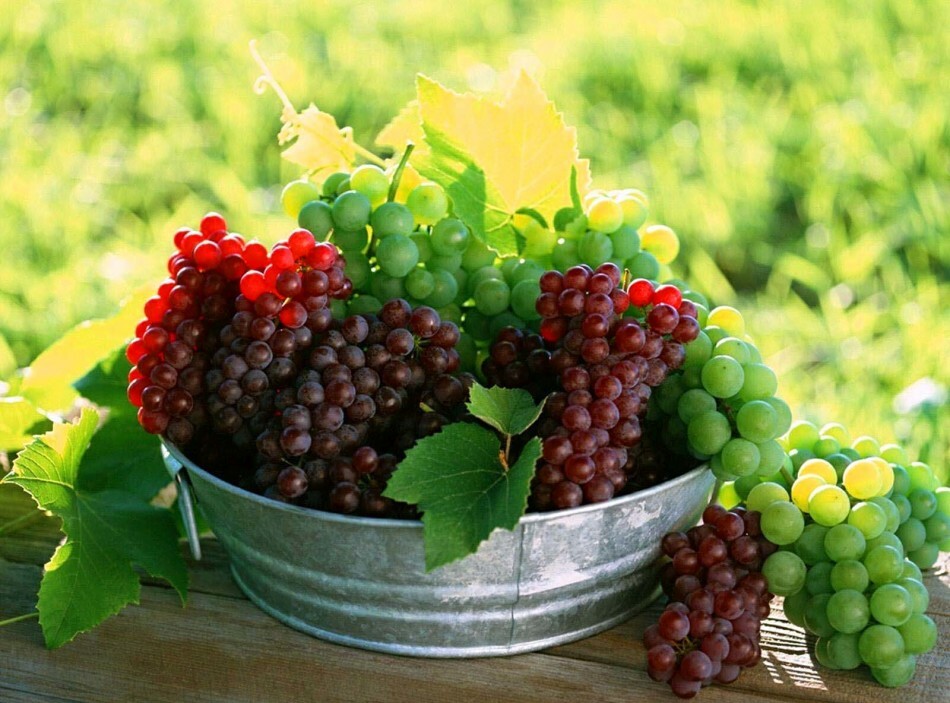 freshly grapes in a bowl before starting making home-made wine
freshly grapes in a bowl before starting making home-made wine - Saperavi
- Stepney
- Novelty
- Friendship
- Festival
- Isabella
- Lydia
- Golubok
- Livadia black
ReChain 1
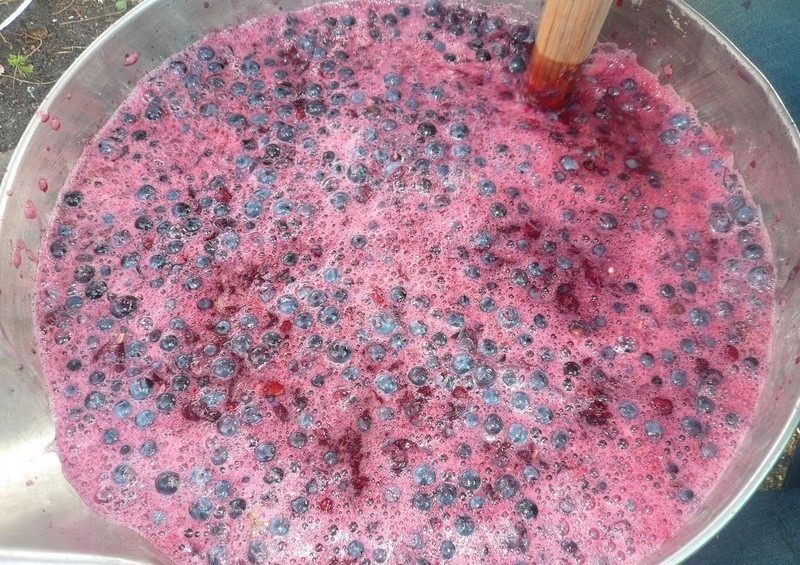 the pulp of the future home wine wanders in the bucket
the pulp of the future home wine wanders in the bucket - Grapes - 10 kg
- Sugar - 250 grams per liter of the future wort
- Water - 100 ml per liter
- Wooden drum or pair of buckets
- Basin or bath
- Glass bottle
- Wooden spatula for stirring
- Flexible hose-siphon - 1 pc
- Colander or gauze or heavy cloth for filtering
- Medical rubber glove
- Dry not washed grapes without leaves and twigs, mash in the mother-in-law / bath
- GetTransfer the mass into a wooden barrel / bucket and leave for 5-7 days to start the fermentation process. Cover the top with a dense cloth
- Mix the mash daily with a wooden spatula so that the foamy cap with the skin disappears
- Strain the mass and let the peel drain off well on the colander
- Sweeten the sugar and add some water if necessary. Remember that it worsens the quality of the future wine, therefore do not be diligent.
- Water only if there is acidity, tartness and tingling of the tongue when tasting the mash for sweetness.
- . Ready the must in a glass bottle and put a rubber glove on its neck, puncture one finger in it
- After a month and a half in the absence of bloated gloves, put the bottle on a table or chair and insert a siphon tube so that it towers above the precipitation by three to five centimeters. The second end is lowered into a clean dry jar / bottle
- Leave the young wine in a cool room with a temperature of 15-18 ℃ for another three to four weeks to mature
- Pour the finished product into smaller containers and lower it into the basement for soaking. Ready wine is suitable for use for the next 5-12 years. A longer term is justified if you did not add water to the
wort Recipe 2
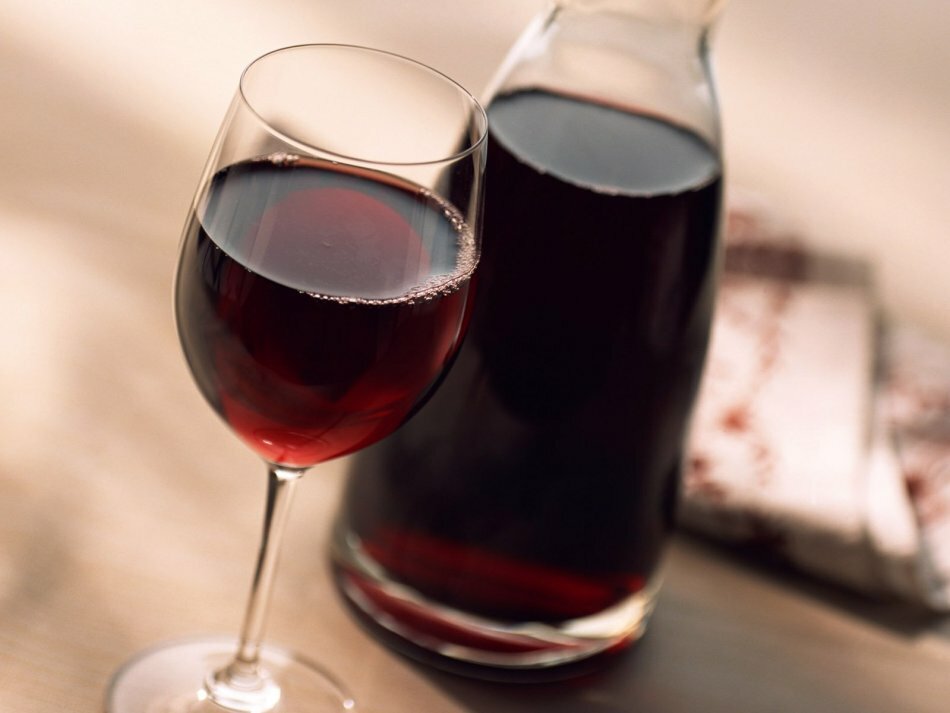 ruby home wine in a glass and a bottle
ruby home wine in a glass and a bottle - Grapes unripe - 10 kg
- Sugar sand - 3 kg
- Three-liter cans
- Medical gloves
- Colander
- Pail
- Wooden spatula
- Dried berries, far from cuttings, crush or toss in a bucket
- Cover the resulting mass with a cloth and put in a warm room for 4-5 days.
- Mix the
- daily with a spatula. When the layer of foam and grape skins pops up, it's time to plant the mass and separate it from the
- skins. Finish the mash in cans, mix with sugar and cover them with medical gloves that are pierced with several fingers.
- By the way, instead of themit is possible to clog jars with stoppers with a gas pipe. One of its ends should be in the water tank and the second one with the
- wort Look after the future wine for three weeks - as soon as the glove ceased to inflate and the sounds of gurgling disappeared, it's time to pour the young wine drink
- Distribute it into a clean dry container, avoidinghitting the sediment
- Take it to a cool place for a month, during which, after separating the yeast on the bottom, three times, pour the young wine into another bowl.
- Put the finished drink in a cool dark place for infusion
- Via meyou need to take a sample of the house wine
Wine from the leaves of the grape
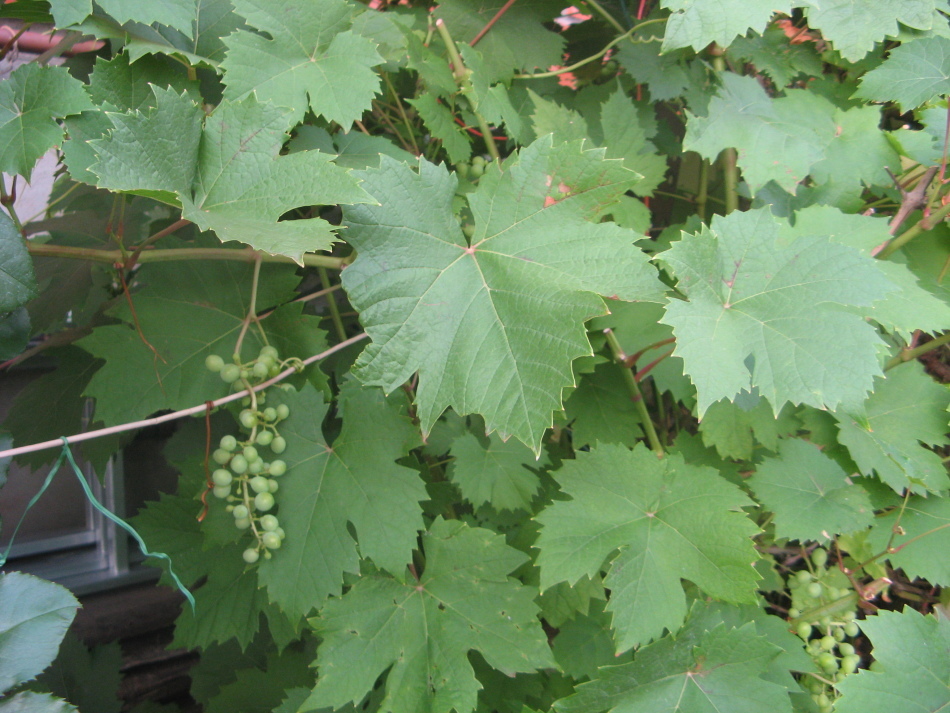 beautiful young leaves of the grapes before the collection for the production of house wine
beautiful young leaves of the grapes before the collection for the production of house wine To do this:
- Collect the young leaves with
- cuttings. Rinse them thoroughly, crush them with a knife and lay them in a glass jar, leaving one third empty. The raw material should be pressed firmly so that it fits tightly
- Pour the jar with steep boiling water and cover with a cork of cotton or cotton wool
- After three days of pouring in a warm place, squeeze out the leaves and strain through the colander with small holes.
- After a couple of hours, strain the future wine so that the precipitateremained in the old container
- Take a glass of infusion and heat it up a little, add 200 g of sugar per liter to this warm liquid
- Well allow and pour into the container with the bulk of the infusion. All mix
- Clean dry jar with infusion put in a hot place where the temperature is held in the region of +25 ℃
- After three days, transfer it to the room and cover with a cork of cotton or cotton wool
- . Once a month, change the container and remove the sediment from the future wine.
- Timeripening of the wine from the leaves - three months, that is, you have to change the banks for it three times
- When the fermentation is over, spill the wine in bottles and store in a cool place.
. How to make wine from isabella at home?
 a couple of glasses of house wine and a bunch of grapes and isabella
a couple of glasses of house wine and a bunch of grapes and isabella Isabella wine technology is simple enough:
- collected in dry sunny weather grapes, remove the berries from the cuttings, remove the spoiled grape
- squeeze the material
- with water, squirt about 40% of the amount of pulp and pour the sugar at a rate of 40 g per each liter
- Within 4 days the sweetened diluted pulp wanders, forming a cap. Pour it with a wooden stick, stirring once a day
- strain the pulp and pour in water, better boiled, approximately 40% of the total wort
- fill the bottle by three quarters, plug it with cotton stopper for the time of active fermentation
- when the wort ceases, replace the stopper onrubber glove punctured on one finger
- as soon as the glove ceased to inflate, remove it, pour a glass of wort, warm and mix with sugar in the proportion of 200 g per liter
- sweet wort mix with the remaining volume and osta month for ripening
- a container with future wine put on the table and with the help of a vinyl tube pour the must into smaller containers
- if desired, sweeten the drink a little more
- store the young wine in a cool place
What sorts of grapes make white wine: the recipe for cooking
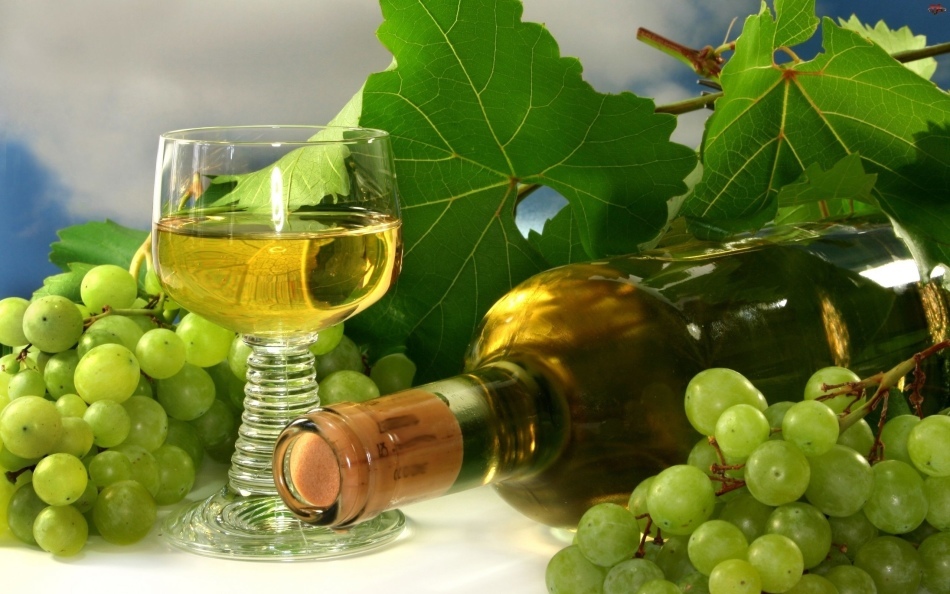 glass, a bottle of white house wine, bunch and leaves of grapes
glass, a bottle of white house wine, bunch and leaves of grapes - Bianka
- Oligote
- Riesling
- of the pulp obtained from crushed mature whole berries, together with wine yeast, wanders for five days.
- . It is covered with a cloth and stands in the warm place of
- . You stir it daily
- and put it in the bottle so that a quarter of it remains free
- installs a water sealfrom a cork with a tube, the second end of which is lowered into a glass with water
- when the active fermentation has stopped, add fresh must to the full filling of the container
- after a month of maturation uncork the bolt and taste the wine for sugar. If your goal is white dry wine, then you do not need to add it. If you want to get semisweet - pour the sugar at the rate of 200 g per liter of
- wort, pour the young drink into bottles and leave in a cool place for a couple of weeks before maturing
- light tone and sediment at the bottom - signs of completing the process of preparation of white wine
- strain it, removing the sediment, pour over new containers and send to the cellar to the nearest feast
What kind of grapes make red wine: the recipe for cooking
 a pair of glasses of home red wine
a pair of glasses of home red wine - Cabernet
- Lydia
- Isabella
- Moldova
You need to prepare:
- Ripened but not spoiled grapes
- Wine yeast
- Sugar in the amount of 50-250 g per liter of wort if you need to get a semisweet / sweet wine
- Bentonite or special clay to lighten a home-made intoxicating drink
- Mug fermentation containerand wort
- Air inlet
- Hydrometer
- Iodine solution for dish disinfection
- Ripe grapes, separated from garbage and twigs, crush hands / feet / press / mash. If you add yeast, you can wash it before that.
- Tanks before use, wipe with iodine aqueous solution to remove microorganisms
- Put the bucket of mush in a warm place for 4 days to start fermentation. If you washed the grapes, pour in the wine yeast
- Foam the cap carefully stir every day, and when it does not break - remove with a spoon
- Strain the wort and wring the grapes that float on the surface
- Measure the juice density with a hydrometer. If it is 15 or lower, add sugar to taste, but not less than 50 g per liter. If within 20-25, leave the wort without sweetening to wander further
- Install the
- air bottle on the bottle of grape juice. For two weeks, periodically shake the
- bottle. When the precipitate separates and drops out, transfer the wort to a new clean and unified container with a siphon tube
- Measure the density. If you introduced sugar the first time, then now add not more than 100 g per liter. If the density index is high at both the first and the second measurement, sweeten the wine altogether.
- Cover the wort with the wort and leave it in the heat for weeks to two.
- A thick, pronounced precipitate signals the need to change the container for the
- juice. Dilute the bentonite in small quantitiesthe wort to the consistency of sour cream. Proportion 2 scoops for 10 liters of liquid
- Enter the solution by stirring the wort
- After a couple of hours, stir again
- Leave in a warm place for a week before precipitate formation
- Pour the young wine into bottles so that the precipitate does not get into them
- Add a little sugar
- Put in a cool bottle basement in a horizontal position
- For the next five years you have a supply of home red wine sweet, semi-sweet or dry, depending on the presence of dissolved sugar
Dry wineat home from grape
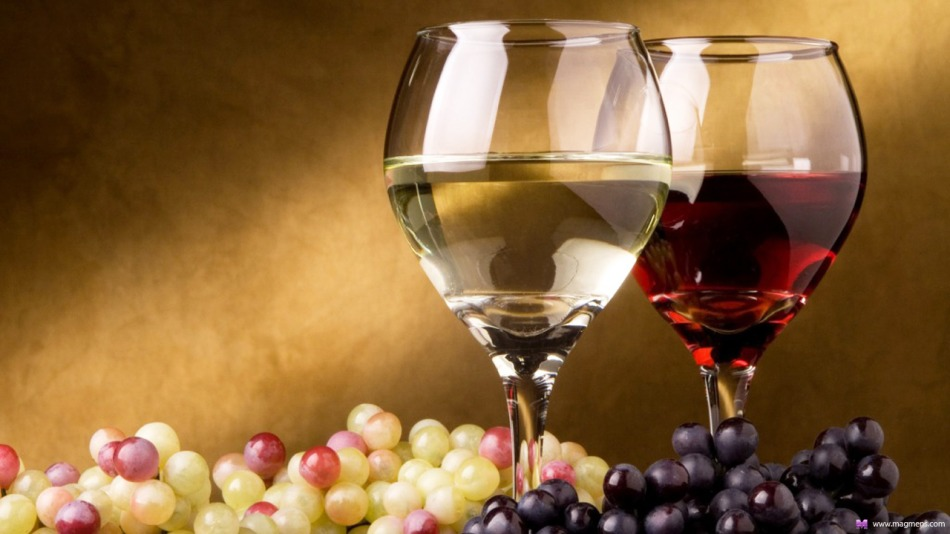 grapes of different varieties, white and red home wine in glasses
grapes of different varieties, white and red home wine in glasses For the basis, take any of the above recipes. The only feature - sugar you do not need as an additional ingredient.
Wine from frozen grapes
 grape berries are covered with frost
grape berries are covered with frost Collect bunches of frozen grapes after a good frost on a clear sunny day.
Frozen berries are frozen neatly on the eve of the New Year at the end of December. Vine should not melt until they are removed from the dose and let in under the press.
The carrot wander for a long time - a few months. The filtered wort is poured into bottles that are well corked and stored in cellars for up to 20 years.
